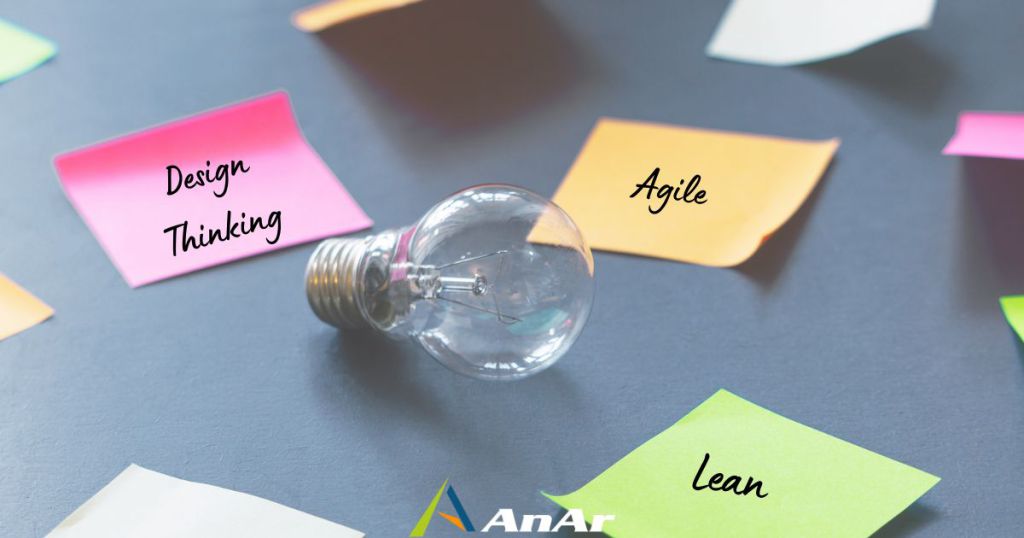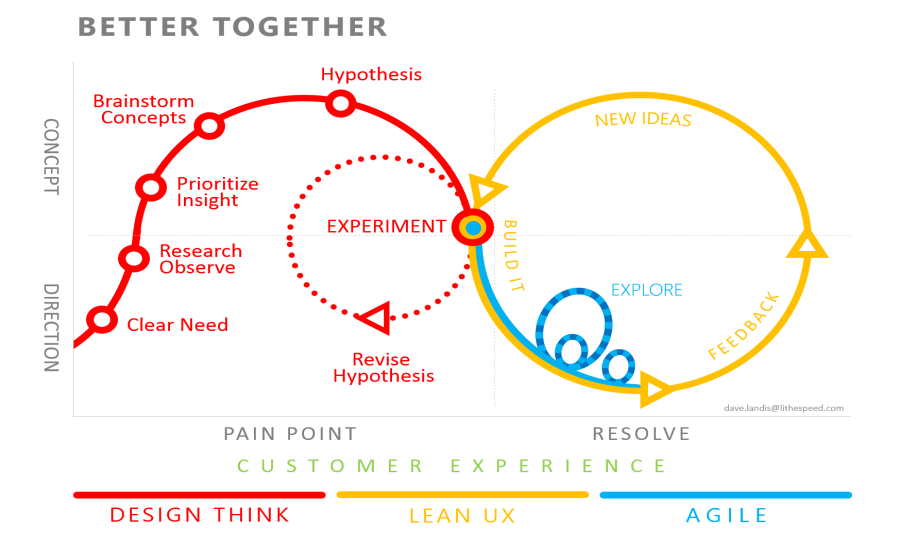In today’s rapidly changing technological landscape, companies are under constant pressure to stay ahead of the curve and remain competitive. The increasing pace of software releases has forced businesses to rethink their approach to innovation and embrace new methodologies and tools that allow for faster, more effective development.
As a result, terms like design thinking, lean, adapt, and agile has become commonplace in the lexicon of business experts and innovators alike. These methodologies offer a range of benefits, from fostering collaboration and creativity to streamlining development processes and improving product quality.
However, it’s important to note that these approaches are not a panacea for all innovation challenges. While design thinking, agile, and lean are certainly valuable tools for generating ideas and testing concepts, they must be used in conjunction with other strategies to achieve long-term success.
In this blog, we’ll explore the nuances of design thinking, agile, and lean methodologies and their role in the innovation process. Join us as we navigate the exciting and ever-changing world of innovation and uncover the strategies and tools that can help your company stay ahead of the curve.
How does combining these approaches contribute to team transformation?
In order to create long-lasting value and truly transform a team, it’s important to blend and align these different approaches in a strategic and thoughtful way. This involves considering a number of factors, including process and strategy alignment, organizational structure, resources, and culture.
By leveraging the power of design thinking, agile methodologies, and lean principles, organizations can drive innovation, improve productivity, and achieve better business outcomes. To achieve this, all aspects of the innovation spectrum — from evaluating models and pricing strategies to supply networks, customer segments, and marketing — must work together in harmony like a well-oiled machine.
By implementing these approaches, businesses can increase their competitive advantage, enhance customer satisfaction, and drive growth. It’s important to ensure that any changes or new approaches are seamlessly integrated with the existing company philosophy and workflow and that the resulting model is designed to drive profitability and success. By taking this approach, teams can enjoy more fulfilling work that generates real results and adds value to the organization as a whole while also attracting top talent and positioning themselves for long-term success.
Planning consideration before running these approaches
To begin with a problem-solving process, it’s crucial to have a clear understanding of the views and expectations regarding the problem at hand. It’s also essential to identify the problem space and develop multiple potential solutions through testing. In the end, the team must plan and execute trials that provide knowledge for continuous improvement of the final solution.
However, for these methods to be successful, the environment must be supportive. Prior to implementing these approaches, it’s important to consider several questions to ensure profitable results.
- Are things clear for working together or alone?
- Are the employees under any pressure to deliver it within a time frame?
- Are the employees comfortable sharing their ideas?
- Is the environment for employees under some sort of fear of being bang on all the time?
Ultimately, effective problem-solving and solution-building are about working collaboratively and achieving success as a team. Therefore, it’s necessary to analyze each aspect of the team’s work environment in detail to ensure the highest level of success.
Understanding Approaches
Before proceeding further, it is important to comprehend the dissimilarity between agile, lean, and design thinking. For newcomers to this area, it might be difficult to distinguish between these three methods of continuous deployment and continuous development.
Each approach has its unique audience, constituents, and process.
Design Thinking is the way we identify and resolve problems.
Lean is the framework we use to evaluate our ideas and navigate our way toward the right solutions.
Agile is the method we use to adapt to changing circumstances with software.
These approaches offer different ways to approach problem-solving and can be used in combination or separately, depending on the situation.
Design Thinking (Identifying)
Design Thinking involves a set of skills and knowledge that enable a designer to deal with uncertainty, combine ideas, and test solutions. These skills are crucial in identifying and addressing complex problems, as well as in generating innovative solutions. It all starts with the process of discovery, which is fundamental to the Design Thinking approach. By identifying problems and exploring possible solutions, designers are able to come up with new and significant concepts.
Design Thinking is a powerful approach that can help individuals and organizations to improve their problem-solving abilities and create effective solutions to meet the needs of their clients and customers. With its emphasis on creativity, collaboration, and experimentation, Design Thinking offers a unique and effective way to tackle the most challenging problems and generate innovative solutions.
Origin of Design Thinking — Design Thinking, originating in the 20th century, applies the industrial-design process to problem-solving through a designer’s mindset. It emphasizes empathy with the target audience throughout the entire process, making it a valuable method for complex problems with ambiguous solutions. Deep user research is essential to understand their perceptions of the problem and test how they would respond to new solutions. This approach is suitable for products and services where usability is crucial for customer value.
Agile (Iterating)
Agile and Lean methodologies are closely related, but they differ in terms of their applications and approaches. Agile is particularly suited to situations where uncertainty is high, as it provides a way to develop software that is adaptable and can evolve over time. Rather than focusing solely on finding the perfect solution, Agile emphasizes the importance of continually improving and iterating on solutions as new information becomes available.
The key characteristic of Agile is its ability to adapt to changing requirements and circumstances in a seamless manner. This enables teams to create software that is robust and can withstand unexpected changes, ultimately leading to greater success and customer satisfaction. By adopting Agile methodologies, teams can not only improve their ability to respond to changing circumstances but also increase their efficiency and productivity, leading to improved business outcomes.
Origin of Agile — The term “Agile” in this context originates from the 2001 Manifesto for Agile Software Development. A group of software developers convened in Utah to propose an alternative to traditional software development, which involved lengthy plans and time horizons. The manifesto drew from emerging methodologies like Scrum and Extreme Programming to hasten the software development process and increase adaptability to change.



Lean Startup (Improving)
Once a solution has been identified and planned, it’s important to integrate lean thinking into the process. Lean thinking is not just a set of tools and methods, and it’s a way of thinking and working that can transform the philosophy of your team. In today’s digital age, complexity, randomness, and dynamism are rampant, making it impossible to control every aspect of a project at all times. To succeed in this environment, we must be able to communicate and work together efficiently through processes, guidelines, and methodologies.
Lean provides a different perspective for managing any kind of work. At its core, Lean is about embracing ambiguity, making decisions through trial and error, and enabling individuals to achieve desired outcomes. Instead of being overly analytical, Lean encourages adaptability and flexibility. By adopting Lean principles, teams can improve their problem-solving abilities, optimize their workflow, and ultimately achieve greater success.
Origin of Lean Startup — “Lean” originated in the 20th century as a way to improve manufacturing and service processes, with Toyota credited as one of the pioneers of its foundational concepts. Instead of increasing scale, Toyota focused on eliminating waste after World War II, developing concepts such as just-in-time inventory and small batches for continuous improvement. The core of Lean is to create an organization where people are empowered to explore better ways of delivering customer-defined value by identifying and removing waste while preserving value.
Together in action
In essence, if you want to generate great ideas, the design thinking approach can be utilized. After that, the lean startup methodology assists in transforming those ideas into functional corporate prototypes. Lastly, the agile methodology helps in delivering the product to the market in a stable and incremental way with the goal of receiving continuous feedback, which can be used to refine and improve the product according to customer needs.
This process can be better understood through the diagram presented below:



In simpler terms, when we combine design thinking, lean startup, and agile approaches, it helps specialists not only come up with excellent ideas but also turn them into profitable solutions by delivering them in a way that creates immediate value for customers and reduces costs and design errors.
However, it is essential to note that to achieve this, it is important to create a solid and reliable prototype that closely resembles the problem or client request. Each of these approaches has unique concerns and requires different learning strategies. So, it is crucial to choose the right approach that suits the specific situation and then implement it effectively to achieve the desired outcomes.
Conclusion
To put it simply, the three approaches of product development — design thinking, lean, and agile — not only help companies create superior products but also enhance their employees’ work potential for a more fulfilling work life. By integrating all three approaches and ensuring that every team member is involved in product discovery and delivery, teams can be transformed and more successful in their product development. It’s important to note that customers don’t care about the approach used as long as the end result is a great product or service that solves their problems. The focus should be on the smooth functioning of the processes, making sure individuals understand the procedures, and utilizing each approach’s philosophy and offerings for continuous development and quick software supply.
All three approaches are vital for meeting the demands of today’s innovative market.





